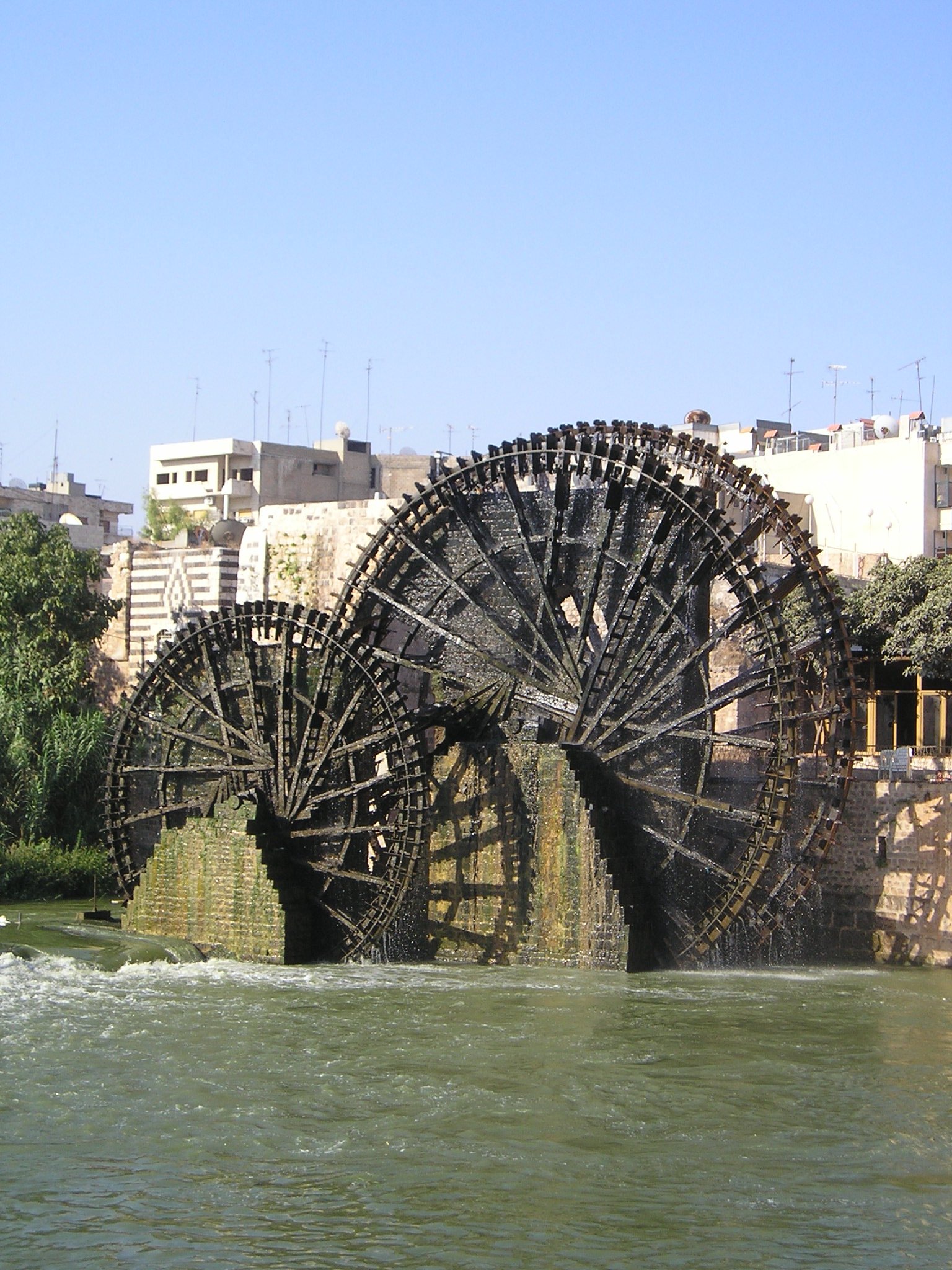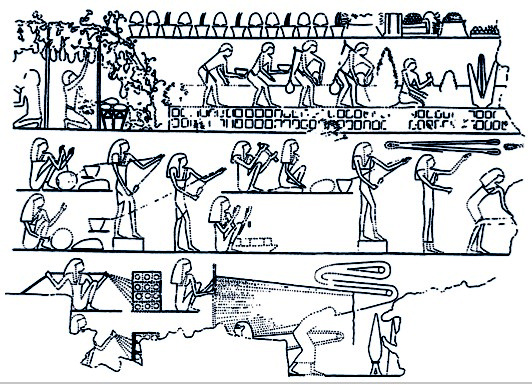|
Noria
A noria ( ar, ناعورة, ''nā‘ūra'', plural ''nawāʿīr'', from syr, ܢܥܘܪܐ, ''nā‘orā'', lit. "growler") is a hydropowered ''scoop wheel'' used to lift water into a small aqueduct, either for the purpose of irrigation or to supply water to cities and villages. Name and meaning Etymology The word ''noria'' is derived from Arabic ''nā‘ūra'' (ناعورة), which comes from the Arabic verb meaning to "groan" or "grunt", in reference to the sound it made when turning. ''Noria'' versus ''saqiyah'' The term ''noria'' is commonly used for devices which use the power of moving water to turn the wheel. For devices powered by animals, the usual term is ''saqiyah'' or ''saqiya''. Other types of similar devices are grouped under the name of chain pumps. However, the names of traditional water-raising devices used in the Middle East, India, Spain and other areas are often used loosely and overlappingly, or vary depending on region. Al-Jazari's famous book on mecha ... [...More Info...] [...Related Items...] OR: [Wikipedia] [Google] [Baidu] |
Saqiyah
A sāqiyah or saqiya ( ar, ساقية), also spelled sakia or saqia) is a mechanical water lifting device. It is also called a Persian wheel, tablia, rehat, and in Latin tympanum. It is similar in function to a scoop wheel, which uses buckets, jars, or scoops fastened either directly to a vertical wheel, or to an endless belt activated by such a wheel. The vertical wheel is itself attached by a drive shaft to a horizontal wheel, which is traditionally set in motion by animal power ( oxen, donkeys, etc.) Because it is not using the power of flowing water, the sāqiyah is different from a noria and any other type of water wheel. The sāqiyah is still used in India, Egypt and other parts of the Middle East, and in the Iberian Peninsula and the Balearic Islands. It may have been invented in Ptolemaic Kingdom of Egypt, Iran, Kush or India. The sāqiyah was mainly used for irrigation, but not exclusively, as the example of Qusayr 'Amra shows, where it was used at least in part to pro ... [...More Info...] [...Related Items...] OR: [Wikipedia] [Google] [Baidu] |
Water Wheel
A water wheel is a machine for converting the energy of flowing or falling water into useful forms of power, often in a watermill. A water wheel consists of a wheel (usually constructed from wood or metal), with a number of blades or buckets arranged on the outside rim forming the driving car. Water wheels were still in commercial use well into the 20th century but they are no longer in common use. Uses included milling flour in gristmills, grinding wood into pulp for papermaking, hammering wrought iron, machining, ore crushing and pounding fibre for use in the manufacture of cloth. Some water wheels are fed by water from a mill pond, which is formed when a flowing stream is dammed. A channel for the water flowing to or from a water wheel is called a mill race. The race bringing water from the mill pond to the water wheel is a headrace; the one carrying water after it has left the wheel is commonly referred to as a tailrace. Waterwheels were used for various purposes ... [...More Info...] [...Related Items...] OR: [Wikipedia] [Google] [Baidu] |
Irrigation
Irrigation (also referred to as watering) is the practice of applying controlled amounts of water to land to help grow crops, landscape plants, and lawns. Irrigation has been a key aspect of agriculture for over 5,000 years and has been developed by many cultures around the world. Irrigation helps to grow crops, maintain landscapes, and revegetate disturbed soils in dry areas and during times of below-average rainfall. In addition to these uses, irrigation is also employed to protect crops from frost, suppress weed growth in grain fields, and prevent soil consolidation. It is also used to cool livestock, reduce dust, dispose of sewage, and support mining operations. Drainage, which involves the removal of surface and sub-surface water from a given location, is often studied in conjunction with irrigation. There are several methods of irrigation that differ in how water is supplied to plants. Surface irrigation, also known as gravity irrigation, is the oldest form of i ... [...More Info...] [...Related Items...] OR: [Wikipedia] [Google] [Baidu] |
Ancient Egyptian Technology
Ancient Egyptian technology describes devices and technologies invented or used in Ancient Egypt. The Egyptians invented and used many simple machines, such as the ramp and the lever, to aid construction processes. They used rope trusses to stiffen the beam of ships. Egyptian paper, made from papyrus, and pottery were mass-produced and exported throughout the Mediterranean Basin. The wheel was used for a number of purposes, but chariots only came into use after the Second Intermediate Period. The Egyptians also played an important role in developing Mediterranean maritime technology including ships and lighthouses. Technology in Dynastic Egypt Significant advances in ancient Egypt during the dynastic period include astronomy, mathematics, and medicine. Their geometry was a necessary outgrowth of surveying to preserve the layout and ownership of fertile farmland, which was flooded annually by the Nile River. The 3,4,5 right triangle and other rules of thumb served to represe ... [...More Info...] [...Related Items...] OR: [Wikipedia] [Google] [Baidu] |
Ismail Al-Jazari
Badīʿ az-Zaman Abu l-ʿIzz ibn Ismāʿīl ibn ar-Razāz al-Jazarī (1136–1206, ar, بديع الزمان أَبُ اَلْعِزِ إبْنُ إسْماعِيلِ إبْنُ الرِّزاز الجزري, ) was a polymath: a scholar, inventor, mechanical engineer, artisan, artist and mathematician from the Artuqid Dynasty of Jazira in Mesopotamia. He is best known for writing '' The Book of Knowledge of Ingenious Mechanical Devices'' ( ar, كتاب في معرفة الحيل الهندسية, lit=Book in knowledge of engineering tricks, translit=Kitab fi ma'rifat al-hiyal al-handasiya) in 1206, where he described 50 mechanical devices, along with instructions on how to construct them. He is credited with the invention of the elephant clock. He has been described as the "father of robotics" and modern day engineering. Biography Al-Jazari was born in the area of Upper Mesopotamia in 1136. Sources state his exact location is unknown, but they speculate he could have ... [...More Info...] [...Related Items...] OR: [Wikipedia] [Google] [Baidu] |
John Peter Oleson
John Peter Oleson (born 1946) is a Canadian classical archaeologist and historian of ancient technology. His main interests are the Roman Near East, maritime archaeology (particularly Roman harbours), and ancient technology, especially hydraulic technology, water-lifting devices, and Roman concrete construction. Life Born in 1946 in Hackensack, New Jersey, United States, Oleson was schooled at the Loomis School in Windsor, Connecticut (1960–64). He received his BA in Classics at Harvard University in 1967, where he studied with Herbert Bloch. Oleson received his MA (1971) and PhD (1973) in Classical Archaeology at Harvard University, working in particular with George M.A. Hanfmann and David Mitten. From 1973–1976 Oleson taught in the Classics Department of Florida State University, Tallahassee. Since 1976 he has been a member of the Greek and Roman Studies Department of the University of Victoria, Canada, where he was appointed Distinguished Professor in 2003. He w ... [...More Info...] [...Related Items...] OR: [Wikipedia] [Google] [Baidu] |
Faiyum
Faiyum ( ar, الفيوم ' , borrowed from cop, ̀Ⲫⲓⲟⲙ or Ⲫⲓⲱⲙ ' from egy, pꜣ ym "the Sea, Lake") is a city in Middle Egypt. Located southwest of Cairo, in the Faiyum Oasis, it is the capital of the modern Faiyum Governorate. Originally called Shedet in Egyptian, the Greeks called it in grc-koi, Κροκοδειλόπολις, Krokodilópolis, and later grc-byzantine, Ἀρσινόη, Arsinoë. It is one of Egypt's oldest cities due to its strategic location. Name and etymology Originally founded by the ancient Egyptians as Shedet, its current name in English is also spelled as Fayum, Faiyum or Al Faiyūm. Faiyum was also previously officially named Madīnet Al Faiyūm (Arabic for ''The City of Faiyum''). The name Faiyum (and its spelling variations) may also refer to the Faiyum Oasis, although it is commonly used by Egyptians today to refer to the city. The modern name of the city comes from Coptic / ' (whence the proper name '), mea ... [...More Info...] [...Related Items...] OR: [Wikipedia] [Google] [Baidu] |
Papyrus
Papyrus ( ) is a material similar to thick paper that was used in ancient times as a writing surface. It was made from the pith of the papyrus plant, '' Cyperus papyrus'', a wetland sedge. ''Papyrus'' (plural: ''papyri'') can also refer to a document written on sheets of such material, joined side by side and rolled up into a scroll, an early form of a book. Papyrus is first known to have been used in Egypt (at least as far back as the First Dynasty), as the papyrus plant was once abundant across the Nile Delta. It was also used throughout the Mediterranean region. Apart from a writing material, ancient Egyptians employed papyrus in the construction of other artifacts, such as reed boats, mats, rope, sandals, and baskets. History Papyrus was first manufactured in Egypt as far back as the fourth millennium BCE.H. Idris Bell and T.C. Skeat, 1935"Papyrus and its uses"(British Museum pamphlet). The earliest archaeological evidence of papyrus was excavated in 2012 an ... [...More Info...] [...Related Items...] OR: [Wikipedia] [Google] [Baidu] |
2nd Century BC
The 2nd century BC started the first day of 200 BC and ended the last day of 101 BC. It is considered part of the Classical era, although depending on the region being studied, other terms may be more suitable. It is also considered to be the end of the Axial Age. In the context of the Eastern Mediterranean, it is the mid-point of the Hellenistic period. Fresh from its victories in the Second Punic War, the Roman Republic continued its expansion in the western Mediterranean, campaigning in the Iberian peninsula throughout the century and annexing the North African coast after the destruction of the city of Carthage at the end of the Third Punic War. They became the dominant force in the Aegean by destroying Antigonid Macedonia in the Macedonian Wars and Corinth in the Achaean War. The Hellenistic kingdoms of Ptolemaic Egypt and Attalid Pergamon entered into subordinate relationships with the Romans – Pergamon was eventually annexed. The end of the century witnessed ... [...More Info...] [...Related Items...] OR: [Wikipedia] [Google] [Baidu] |
Fresco
Fresco (plural ''frescos'' or ''frescoes'') is a technique of mural painting executed upon freshly laid ("wet") lime plaster. Water is used as the vehicle for the dry-powder pigment to merge with the plaster, and with the setting of the plaster, the painting becomes an integral part of the wall. The word ''fresco'' ( it, affresco) is derived from the Italian adjective ''fresco'' meaning "fresh", and may thus be contrasted with fresco-secco or secco mural painting techniques, which are applied to dried plaster, to supplement painting in fresco. The fresco technique has been employed since antiquity and is closely associated with Italian Renaissance painting. The word ''fresco'' is commonly and inaccurately used in English to refer to any wall painting regardless of the plaster technology or binding medium. This, in part, contributes to a misconception that the most geographically and temporally common wall painting technology was the painting into wet lime plaster. Even in app ... [...More Info...] [...Related Items...] OR: [Wikipedia] [Google] [Baidu] |







.jpg)